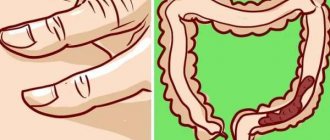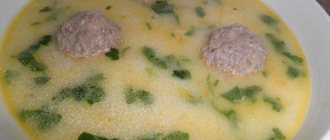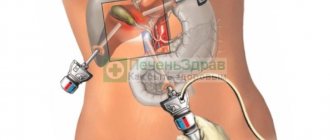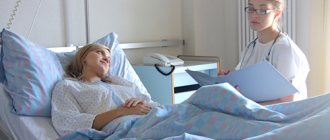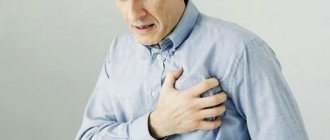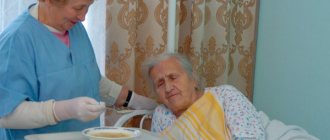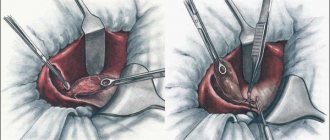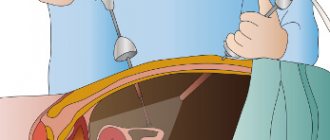Rules for bowel movement for hemorrhoids
With hemorrhoids, the patient constantly experiences pain, which increases significantly during bowel movements. To slightly reduce its intensity and speed up the treatment process, you should learn how to go to the toilet correctly. Following the recommendations is already half the success, as well as an opportunity to help your body recover faster.
Absolutely all people are recommended to follow the rules of defecation to prevent the occurrence of hemorrhoids. Basic rules on how to go to the toilet with hemorrhoids:
- At the first urge, you should immediately go to the toilet; patience significantly aggravates the disease.
- The back should be straight, the stomach should be relaxed.
- The knees should be higher than the hips, the elbows can be rested on the knees, and the head can be supported with the palms.
- Defecation should be quick, not long.
In addition to the above rules created by world proctologists, it is worth following the following recommendations:
- food must include cereals, oils, and dairy products. You need to drink about 1.5-2 liters of water per day;
- based on your body’s biological clock, get used to defecation at one time, for example, in the morning or evening;
- Underwear must be changed every day;
- wash after defecation with slightly warm water;
- For frequent constipation and problems with bowel movements, use special medications.
How to alleviate the condition?
How to go to the toilet with hemorrhoids? During the development of hemorrhoids, unpleasant consequences often occur. Proctologists do not recommend treating the disease at home. Under such conditions, hemorrhoids will only increase even more. Only a doctor can prescribe effective medications for the disease. During therapy, it is important to follow the recommendations of specialists.
- Follow the regime. Proctologists say that it is best to have a bowel movement after waking up or before going to bed. You can also focus on your own biorhythms - the main thing is to go to the toilet at the same time.
- We respond in a timely manner. If you want to empty your bowels, there is no need to postpone this process until later, since the act of defecation will be much more painful.
- We control the time. With hemorrhoids, the urge to go to the toilet occurs more often. In some cases, bowel movements do not follow the urge. Under such conditions, it is not recommended to sit on the toilet for a long time and wait for the result. After a few minutes of fruitless process, it is better to return to your work until more distinct urges appear.
- Choosing the right pose. To avoid overstraining your muscles, it is recommended to empty your bowels in the correct body position. Your back should be straight and your feet should be placed on the floor. In a bent position, the process of defecation becomes more difficult, since the stool is compressed.
- We follow the rules of hygiene. After defecation, it is necessary to wash yourself and wipe the anus with wet wipes or soft paper.
Before going to the toilet if you have hemorrhoids, you should know that it is forbidden to use hard toilet paper, as it can provoke the development of a severe inflammatory process. Under such conditions, the hemorrhoids will become even larger and become inflamed.
Visiting the toilet by pregnant women
Hemorrhoids after using the toilet are a common occurrence in pregnant women, especially in the second trimester. This is due to a strong enlargement of the uterus, which, in turn, puts pressure on the rectum and causes blood stagnation.
In pregnant women, like in other patients, there are four stages of hemorrhoids. The last stage is very dangerous due to the appearance of heavy bleeding.
When visiting the toilet with hemorrhoids, pregnant women may experience such symptoms.
- Pain during bowel movements, minor bleeding, discomfort.
- Itching after defecation, discharge from the anus, pain radiating to the sacrum or lumbar region.
- Prolapse of intestinal nodes, which can only be set manually.
- Prolapsed nodes that cannot be set, profuse bleeding.
Symptoms
Hemorrhoids can be internal or external. With internal hemorrhoids, the nodes remain inside the rectum, while with external hemorrhoids, they fall out. A prolapsed hemorrhoid interferes with walking and sitting and makes it difficult to go to the toilet. In its development, the disease goes through 4 stages. Depending on the degree, the symptoms of the disease look like this:
| Stages of hemorrhoids | Signs |
| 1st and 2nd | General symptoms are mild |
| Minor spotting after bowel movements | |
| Pain and itching | |
| Prolapse of hemorrhoids that retract back into the anus | |
| 3rd and 4th | Painful heaviness in the anus |
| Heavy bleeding after going to the toilet | |
| Bloody feces | |
| Prolapse of nodes that do not retract when coughing, sneezing, or lifting heavy objects | |
| It is very painful to go to the toilet | |
| Necrosis of hemorrhoids |
How to go to the toilet after surgery?
After undergoing surgery to remove damaged tissue from part of the intestine, the patient may not immediately return to normal rhythm. This is due to the fact that sutures and scars remain on the intestine. If defecation is incorrect during the postoperative period, tissue rupture in this area and bleeding are possible. Therefore, the patient is given strict recommendations after surgery.
- A special diet high in fiber. Food should be light and not contain foods that cause increased gas formation. Also, on the first day after surgery, the patient is prohibited from eating.
- The next stage is to eat frequently, but in small portions. About 5-6 times a day is considered optimal.
- Since frequent constipation is possible after surgery, you should combat it by taking laxatives or suppositories.
The patient is also prescribed painkillers and medications that relieve spasms of the anal sphincter. Prescribed means for the fastest healing of sutures.
What medications will help you go to the toilet painlessly?
If the diet is ineffective, the proctologist may recommend taking laxatives that soften stool, improve intestinal motility and facilitate bowel movements.
Laxatives for hemorrhoids are prescribed one-time or in a course, depending on how long the constipation has been. You cannot use portable products constantly, as this will lead to “lazy bowels” and then going to the toilet without them will simply become impossible.
Laxatives are available in various dosage forms: tablets, syrups, capsules, drops and microenemas. The most effective and popular laxatives today are the following:
- Duphalac;
- Regulax;
- Normaze;
- Picolax;
- Senade;
- Bisocodil;
- Norgalax;
- Microlax;
- Normacol;
- Castor oil;
- glycerin suppositories.
How to improve bowel movements with hemorrhoids?
In addition to diet and correct posture during bowel movements, bowel movements with hemorrhoids can be improved with medication or with the help of folk remedies. Medicines are also prescribed if hemorrhoids hurt.
With the help of medications
Improving bowel movements with the help of medications is aimed at relieving pain and combating constipation. Moreover, it has been noted that suppositories, ointments and gels help with hemorrhoids faster than tablets or capsules.
The most effective drugs for pain relief are presented below.
- Anal suppositories based on belladonna extract. Excellent for relieving pain and eliminating sphincter spasms.
- Procto-Glivenol. Relieves pain and has an anti-inflammatory effect.
- Relief candles. They fight pain, heal intestinal cracks, and cope with inflammation.
- Anestezol. Relieves pain, inflammation, heals microtraumas.
The most popular drugs to combat constipation and hemorrhoids.
- Castor oil.
- Glycerin based suppositories.
- Duphalac.
- Enema with castor oil.
Any use of medications for this disease is possible only after consultation with a specialist.
Folk remedies
Treatment and prevention of hemorrhoids with folk remedies is carried out even during pregnancy. But it is advisable to coordinate the use of this type of therapy with a doctor, so as not to complicate the course of the disease. Recipes for folk decoctions and tinctures against hemorrhoids:
- Taking herbal baths. To do this, you will need to prepare a herbal decoction of nettle, chamomile, and plantain. All herbs need to be mixed and pour 2 liters of boiling water. Leave for at least 2 hours, then strain and dilute with warm water to obtain 5 liters of liquid. It is necessary to take such a bath for 7-10 minutes. The course lasts 2 weeks.
- Compress. To prepare the compress you need potatoes, about 10-12 pieces. Each potato needs to be washed and grated on a fine grater. It is worth rubbing together with the skin. Lay cellophane on a chair or bed, fold the twelfth part of the grated pulp into a cloth and place it on the cellophane. You need to sit on top of the cloth so that the hemorrhoids are in contact with the potatoes. Next, you should cover yourself to create a warm effect. It is necessary to sit for 10-15 minutes over each compress. A total of 12 procedures are performed.
Difficulty going to the toilet
In no case should you hold back bowel movements for a long time; this is dangerous due to complications such as colitis, inflammation of the rectum, paraproctitis and even cancer.
Defecation with hemorrhoids will be painful, and inaction can result in rectal cancer.
With hemorrhoids, going to the toilet in large quantities is associated with excruciating pain and strong efforts. Constipation is a consequence of improper and irregular nutrition. When bowel movements occur less frequently than every 1-2 days, the stool becomes hard. A person has to push hard and sit on the toilet for a long time, which causes a large rush of blood to the pelvic organs. The danger is that a hard fecal lump can pierce the walls of the rectum and cause peritonitis. Posture during bowel movement is of great importance. You cannot sit on the toilet with a straight back - this makes it difficult to pass feces. Hard toilet paper rubs the skin of the anus and injures prolapsed nodes. You need to be especially attentive to your health in the period after hemorrhoid removal.
Causes of hemorrhoids
The appearance of the disease is provoked by factors:
- hormonal changes in the body;
- unbalanced diet;
- low physical activity;
- heredity;
- stress;
- excessive physical activity;
- bad habits.
Pain occurs when the rectal mucosa is damaged by feces. Patients develop a fear of defecation. Constipation develops - the reluctance to go to the toilet with hemorrhoids becomes stronger.
Pain may occur if you spend a lot of time sitting on the toilet. Blood rushes to the veins, causing swelling of the hemorrhoids. Intensified attempts lead to injury to the anal canal with hard feces.
Seeing a specialist is a prerequisite for effective treatment, since hemorrhoids have symptoms similar to other dangerous diseases. Fecal masses may contain blood due to proctitis, polyps, and neoplasms of various etiologies.
Note to patients
If a person experiences severe discomfort or pain in the anus during bowel movements, it is important to immediately consult a proctologist, since this condition is not normal. It is necessary to take medications strictly according to the recommendations of the attending physician. Frequent urge to go to the toilet with hemorrhoids can also be caused by other serious illnesses.
- Chronic combined hemorrhoids, stage 2 treatment
- How to insert suppositories for hemorrhoids correctly
- Hemostatic drugs for hemorrhoids - the best tablets
- Duration of treatment for hemorrhoids: how many days does it take for hemorrhoids to go away when treated with medications, after surgery, during pregnancy, in the elderly
Traditional methods for eliminating pain from hemorrhoids
Surgery will help you get rid of hemorrhoids quickly. In the first and second stages of the disease, when hemorrhoids can be palpated, do not cause pain, do not bleed, and are straightened after defecation without the help of hands, it is possible to use traditional medicine.
Using medicinal plant oils to ease bowel movements for hemorrhoids
Oils from medicinal plants are widely used in the treatment of hemorrhoids:
- Sea buckthorn oil is used in the form of compresses to relieve pain when going to the toilet. They help eliminate swelling, expand the lumen of the anal canal, and under the influence of oil, the vascular walls become more extensible and resistant to damage. If traces of blood are visible on paper after defecation, the use of oil compresses is advisable. For internal hemorrhoids, it is recommended to place a microenema with 50 ml of oil in front of the toilet.
- Camphor oil has a healing, anti-inflammatory, antiseptic effect. Used during bowel movements, applying to the anal area with smooth movements. For internal hemorrhoids, use a tampon soaked in camphor oil.
- Castor oil effectively copes with bowel movements if it is painful to go to the toilet due to hard stool. A bath (15 drops of oil per 4 liters of water) will relieve pain. Internal nodes are treated by inserting oil capsules into the anus.
- Fir oil is used in the form of lotions on hemorrhoidal cones and suppositories. You can make it at home. For 200 g of butter, add 30 g of fir oil, an auxiliary agent - 30 g of beeswax. The ingredients are melted in a water bath, and candles are formed from the mixture.
- Flaxseed oil is rich in Omega-3 and Omega-6 acids, which help normalize metabolic processes in the body, relieve constipation, and increase the elasticity of blood vessels. In folk medicine, a mixture of flaxseed and sea buckthorn oil is used in a 1:1 ratio with 1 part of calendula flowers. A tampon with the mixture is applied to hemorrhoidal cones for a week at night.
- Tea tree oil is used in the form of baths and reduces pain after bowel movements. The use of the product should be avoided by pregnant women.
- Milk thistle oil is considered a powerful immunostimulant and has excellent regenerating properties. Daily administration of 30 ml of oil using enemas, and the introduction of suppositories made from a mixture of butter and milk thistle oil will help cope with the problem of painful bowel cleansing.
Using butter in the treatment of hemorrhoids
Butter effectively relieves pain associated with hemorrhoids. Due to the high content of vitamins A, B, C, D, E, minerals and protein, it reduces bleeding and has a calming effect.
It is common to use a mixture of butter and honey in a 1:1 ratio for insertion into the anus, and candles made from oil with the addition of flaxseed and chamomile. Making candles involves heating a mixture of oil and herbs over low heat for an hour, straining, adding beeswax, and forming suppositories. Used for anal pain.
Use of garlic in the treatment of hemorrhoids
Garlic has many healing properties. To prepare the ointment, you need to pass 200 g of peeled garlic through a press, add 1 tsp. honey, 50 ml cow's milk. Cook the mixture over low heat until thickened, avoiding the appearance of lumps. The ointment is infused for 3-4 hours, after which it is applied to the hemorrhoids.
To treat internal hemorrhoids, garlic suppositories are prepared. Mix peeled, ground garlic and butter in a 1:1 ratio. A candle is formed from the mixture. Before going to bed, it is inserted into the rectal opening.
Garlic baths are used. To prepare, grind the garlic until mushy and mix with five liters of warm water. Take a bath twice a day.
The use of decoctions of medicinal herbs in the treatment of hemorrhoids
Decoctions of medicinal herbs for hemorrhoids reduce inflammation, relieve spasms, and improve blood flow.
Chamomile decoction can relieve itching, pain, inflammation of the nodes, and irritation of the anus after using the toilet. To prepare the baths, chamomile flowers (30 g) are poured with boiling water (2 liters) and used after 2-3 hours. The bath is taken for 10-15 minutes daily.
Often with hemorrhoids, swelling appears, causing pain. Lotions and baths made from bay leaf infusion (10 g of crushed leaf per 2 cups of water) will help. Carrying out 10 procedures gives a positive effect.
You can start using aloe juice in the form of lotions and suppositories made from pulp. To make it, you need to remove the skin from the leaf, arrange the pulp in the form of a candle, and insert it into the anus overnight.
The herb Knotweed contains components that dilute stool. The daily portion of the infusion is prepared in the proportion of 1 tbsp. l. herbs per 400 ml of boiling water. Prepare the infusion at night, drink 3 times a day.
An ointment made from crushed plantain leaves mixed with butter or peach oil is used when the anus area hurts, to heal wounds and cracks.
Traditional medicine methods are most effective in the early stages of the disease. Can be used in difficult cases as auxiliary therapy.
Traditional recipes to help
Traditional medicine will help you cope with the painless act of cleansing the intestines without drugs.
- Castor oil helps to irritate the intestinal walls and soften its contents. The drug is taken orally 15-20 ml in the morning on an empty stomach. Within 2 hours you will see the desired result.
- Dry raw materials from yarrow flowers, buckthorn leaves and nettles are poured with boiling water and infused. The decoction should be taken three times a day. Inflammation and swelling may subside the very next day.
- Bran soaked in boiling water helps to cope with constipation. Intestinal peristalsis is activated, toxins are removed from the body. The mucus released from the product envelops the stool, softens it and facilitates the process of emptying.
- Burdock seeds are poured with water and taken three times a day.
- Rowan juice has a laxative effect, heals wounds and prevents infection. Ripe rowan juice can be mixed with honey or sugar. You need to drink before meals.
- An ointment based on butter, petroleum jelly and tobacco can eliminate constipation, reduce pain and burning. All components must be mixed and passed through a sieve.
If you follow your doctor’s recommendations and adjust your diet, you can forget about the unpleasant signs of the disease for a long time. Laxatives can only temporarily improve the situation, so you need to follow a diet constantly.
The use of traditional medicine for hemorrhoids during pregnancy
Hemorrhoids during pregnancy and after childbirth are a common phenomenon.
Pregnant women cannot go to the toilet due to fear of pain, itching, burning during bowel movements, and fear of seeing blood on toilet paper.
A doctor can help by prescribing treatment that is safe for the expectant mother and child. The use of traditional medicine methods is permissible after consultation with a doctor.
After defecation, it is recommended to wash with cool water using baby soap, and irrigate with decoctions of chamomile and calendula. Therapeutic baths should not be hot, so as not to provoke increased uterine tone.
The best option for achieving painless stool during pregnancy is to correct your diet, avoid hard stools, and have regular bowel movements.
Healthy eating is a method of preventing painful stools
Sometimes with hemorrhoids you constantly want to go to the toilet due to the accumulation of dense feces.
Proper nutrition is the main factor in normalizing stool and facilitating bowel movements. Patients are introduced to their diet with foods rich in fiber. Effectively absorbs water, leads to an increase in the volume of stool, eliminating constipation. We must not forget about the need for sufficient (at least 2 liters per day) water consumption.
The menu should include fruits, vegetables, vegetable oil. Cereals - buckwheat, oatmeal, pearl barley, barley - perfectly cleanse the intestines during hemorrhoids.
It will make going to the toilet easier by eating a mixture of ground dried fruits: prunes, dried apricots, figs. Regular consumption of beet juice and vegetable oils in a volume of 50-60 g per day will avoid hardening of stool and the appearance of blood on paper after defecation.
Folk remedies
With the help of folk remedies, you can relieve the pain that appears at the time of defecation with hemorrhoids. Various oils are used for this:
- sea buckthorn - leads to an increase in the rectal canal, expansion of the walls, becoming more resistant to injury. If you have internal hemorrhoids, you can do an enema with the addition of 50 ml of the product;
- milk thistle oil - if hemorrhoids come out after using the toilet, perform an enema with 30 ml of the substance;
- tea tree - produce baths to relieve pain after bowel movement;
- castor oil - thins out dense stool. To make it easy to go to the toilet after surgery, the product is used orally (1 g/1 kg of a person’s weight) or in capsule form (25-30 pieces before bedtime). For an enema, add a few drops to warm water.
You can walk around without difficulty after hemorrhoid surgery if you use popular laxatives and follow traditional recipes. However, the main thing remains your own peace of mind, healthy nutrition and a positive psychological attitude.
We recommend: How to get rid of itching from hemorrhoids - effective methods
Exercise to prevent constipation and painful stools
Physical therapy will be an auxiliary means of eliminating constipation.
When working sedentarily in an office, you need to get up every hour and do exercises to eliminate blood stagnation. Light running, walking with knees raised, and circular movements of the torso are useful.
When the disease worsens, walking is painful, so it is advisable to start treatment with breathing exercises in a lying position.
An effective, simple exercise for stool regulation is used by Indian yogis. The abdomen retracts as much as possible when exhaling, and protrudes as much as possible when inhaling. If you perform the exercise 100 times a day, the need for a cleansing enema will disappear. It is effective to throw your legs behind your head in a lying position 25-30 times, the “bicycle” exercise. The outflow of blood from the pelvic organs will ease discomfort and eliminate swelling.
It is necessary to adhere to a healthy lifestyle after hemorrhoids - it will not allow the disease to return.
If the disease is not in an advanced stage, coping with hemorrhoids and painful manifestations will not be difficult, having traditional medicine in your arsenal. The main weapon in the fight against hemorrhoids is a positive psychological attitude, a healthy lifestyle, increasing immunity and taking constant measures to prevent the disease.
Despite the sensitivity of the problem, the question of how to go to the toilet with hemorrhoids, constipation and other unpleasant situations is asked by people all over the world. In this regard, even special international recommendations for proper bowel movements have been developed. This is especially difficult to do in case of serious proctological diseases. In the advanced clinical stage of hemorrhoids, a person experiences excruciating pain, especially aggravated by defecation, but restraining the process further aggravates the problem. No less difficulties arise for patients who have undergone surgery on the rectum; it is important for them to learn how to go to the toilet correctly and painlessly after removal of hemorrhoids. It is useful for all concerned people to know about the relevance of the issue and its optimal solution.
It hurts to go to the toilet in a big way: folk remedies will help
To prevent pain in the anus due to hemorrhoids during and after using the toilet, you can use folk remedies, which in this case are almost as effective as traditional laxatives.
The following folk remedies will help relieve constipation and help you go to the toilet painlessly:
- natural laxative made from dried fruits. Prunes, dried apricots and figs in equal quantities are passed through a meat grinder, after which one tablespoon of the resulting mass is eaten 40 minutes before meals three times a day;
- brush salad. One raw carrot and one beet are peeled and grated on a fine grater. ¼ of a head of cabbage is finely chopped, mixed with beets and carrots, then seasoned with two tablespoons of vegetable oil. The resulting salad is divided into three doses and eaten throughout the day;
- Decoction of senna leaves. Two tablespoons of dry plant extract are poured into 250 ml of boiling water, covered with a lid and simmered over low heat for 15 minutes, then filtered through a fine sieve. For constipation, you need to drink 100 ml of senna decoction in the morning on an empty stomach, repeat the dose if necessary. Plants such as buckthorn, rowan, licorice root, nettle and lingonberry also have a laxative effect;
- Beetroot juice. Drinking freshly squeezed beet juice daily will help avoid problems with stool;
- Vegetable oil. To prevent constipation, it is recommended to consume two tablespoons of any vegetable oil in the morning on an empty stomach.
Now you know how to properly go to the toilet with hemorrhoids so that bowel movements are painless. We will be glad if the information provided was useful to you. Leave your feedback in the comments under this topic.
Why is there a problem?
Hemorrhoids do not appear out of nowhere; they are based on the anatomical features of the venous plexuses of the rectum and a hereditary predisposition to the disease. However, for the transition from normal to pathology, the presence of a number of predisposing factors is very important, one of which is chronic constipation.
Impaired activity of the large intestine is most often a consequence of poor nutrition or a sedentary lifestyle, although there are other serious causes (tumor, congenital malformations, etc.).
Severe straining creates increased pressure inside the abdominal cavity, the outflow of blood through the veins of the rectal plexuses is disrupted, stagnation occurs, vasodilation and the formation of hemorrhoidal nodules inside the anal canal or under the skin around the anus. In the initial stages, hemorrhoids do not bother you, but as the disease progresses, pain appears, which greatly complicates the process of bowel movement. Why does it hurt to go to the toilet when you have hemorrhoids? There may be several reasons:
- accumulation and hardening of feces with subsequent damage to the rectal mucosa;
- formation of anal fissure;
- sitting on the toilet for a long time - this leads to increased blood flow to the rectum, enlarged nodes and blocking the lumen of the anal canal;
- failure to comply with hygiene rules for the care of the perineum and anus;
- restraining the urge to have a bowel movement due to psycho-emotional or physical reasons.
Because of the pain, constipation with hemorrhoids intensifies even more, which in turn contributes to increased stagnation of blood in the pelvis, a vicious circle arises. Proctologists teach that you need to have a bowel movement at the first urge, but what to do if pain interferes? Learn from a specialist, regardless of the sensitivity of the issue.
Why do hemorrhoids hurt after defecation?
Defecation with hemorrhoids is almost always accompanied by pain of varying intensity, as well as bleeding. The main reason for these unpleasant symptoms is damage to hemorrhoids or irritation of the inflamed tissues of the anus with feces. This contributes to the fact that the patient is afraid of the upcoming bowel movement, and fears and worries negatively affect the state of the human body.
Hemorrhoids can hurt during and after bowel movements for several reasons, namely:
- constipation. Due to prolonged constipation, stool hardens, so it can damage the intestinal mucosa and the hemorrhoids themselves, causing bleeding and pain. You can eliminate constipation by adjusting your diet, increasing the amount of fluid you drink and increasing your physical activity. It is also important to exclude the presence of stomach diseases that are accompanied by increased acidity of gastric juice, since hyperacinic conditions lead to hardening of stool;
- long sitting on earthenware. While sitting on the toilet, blood flow to the vessels of the anus increases, as a result of which the size of hemorrhoids increases, which interfere with the normal passage of feces through the rectum;
- severe straining during bowel movements. Excessive pushing also increases blood pressure in the vessels of the rectum, as a result of which hemorrhoids enlarge and pain increases;
- poor anal hygiene. If the patient rarely washes himself or takes a shower, then the skin of the anus becomes rotten, leading to inflammation of the external hemorrhoids, and, accordingly, pain during bowel movements;
- conscious suppression of the urge to have a bowel movement. Because of the fear of pain during defecation, patients deliberately suppress the urge to defecate, which in the future will turn into constipation, since the feces will stagnate in the intestines and harden.
Rules for defecation
It is advisable for everyone to follow international recommendations on proper bowel movements to prevent hemorrhoids or other proctological diseases. What is their essence:
- You cannot tolerate, suppress the urge and deliberately delay the moment of defecation.
- You need to sit on the toilet so that your knees are higher than your hips; to do this, you can place a small stool under your feet, rest your elbows on your knees, and support your chin with your palms.
- During bowel movements, you need to relax your stomach and straighten your back.
- The act of bowel movement should take place simultaneously without long sessions in the toilet.
If a person has an anal fissure or enlarged nodes in the anal canal, the process may be difficult due to pain. Such people complain: “Going to the toilet feels like torture.” The situation is difficult, but not hopeless, and advice from a specialist can help. How to painlessly go to the toilet with hemorrhoids:
- stick to a schedule - each person has his own biological clock, it is better to accustom the body to morning or evening bowel movements, the norm is to have a bowel movement at least once every 1-2 days;
- review your diet - to prevent constipation, be sure to consume plant-based dietary fiber, cereals, fermented milk products and a sufficient amount of regular drinking water (about 2 liters per day);
- do not turn the toilet into a place for relaxation; the act of defecation should be immediate;
- maintain the correct posture while sitting on the toilet, according to international recommendations of proctologists;
- wash yourself after each trip to the toilet with cool water or use wet wipes for intimate hygiene instead of rough toilet paper;
- change underwear daily;
- to prevent damage to the mucous membrane, you can periodically do counter microenemas with 50 ml of vegetable oil 5-10 minutes before the expected bowel movement or use rectal suppositories (for example, glycerin) in the morning 15-20 minutes before bowel movement;
- if it is impossible to have a painless bowel movement on your own, use safe laxatives to soften stool - Duphalac, Forlax, Normaze, etc.
Useful tips
It's time to consider recommendations that will help you painlessly go to the toilet with hemorrhoids, or at least reduce severe pain. So, you need:
- strictly control the regularity of stool. Defecation should not be less than once every 1-2 days. A person needs to make a schedule for visiting the toilet, taking into account the individual characteristics of his body and lifestyle. It is recommended to use laxatives, normalize nutrition and increase physical activity. In this way, it will be possible to prevent constipation and feel relief during bowel movements;
- control the time spent on the toilet. In order not to overstay your welcome, it is advisable to remove distracting objects such as magazines, books, telephone or crossword puzzles from your field of view. A person sitting on the toilet for a long time and straining his abdominal muscles increases the risk of blood stagnation and swelling of hemorrhoids. If defecation does not take place, it is recommended to leave the toilet and wait for a more opportune moment when the urge is stronger;
adhere to a dietary diet. You can make defecation easier for hemorrhoids by normalizing your diet. A person is recommended to eat fruits (plums, apples), raw vegetables (pumpkin, cucumbers, tomatoes), cereals, soups and milk (ryazhenka, kefir). Special attention should be paid to drinking volume. So, you need to drink at least 1.5 liters of liquid per day. This can be non-carbonated mineral water, compotes, fruit drinks, green tea or herbal decoctions. Prohibited foods include products that increase gas formation in the intestines, for example, cabbage, legumes, and radishes;- do not ignore the urge to defecate. Despite the risk of pain, a person should visit the toilet as soon as he feels like doing so. If he endures it, perhaps the next urge will appear only after 1-2 days. Thus, the patient unknowingly provokes constipation;
- take a comfortable position. It is undesirable to strain your abdominals and intestines while in a squatting position. This usually happens in public toilets with questionable cleanliness of the seats. This further disrupts local blood flow and worsens congestion. A person needs to focus on the feet and back of the thighs while sitting on the toilet, which will allow them to relax and facilitate the process of bowel movements;
- change your lifestyle by increasing physical activity. So, it is recommended to do morning exercises, spend more time in the fresh air, walking in the park. It is especially important to take so-called “active breaks” for people who sit for long periods of time. It is advisable to get up and stretch every 2-3 hours;
- observe hygiene rules. The main task for hemorrhoids is to keep the perineum clean. So, it is necessary to wash the anus after each visit to the toilet, thereby reducing the risk of developing inflammation. If this is not possible (due to work or other reasons), you need to replace the paper toilet paper or wet wipes. Underwear should be changed daily to prevent skin irritation and scratching. Washing should be done with warm water, since hot water provokes blood flow to the nodes, which is undesirable for hemorrhoids. Cleansing the perineum should be carried out in the direction from the anus to the tailbone. In addition, you need to keep the area dry, as moisture increases the risk of skin irritation, which in turn causes itching.
Defecation after surgery
Classic surgical treatment of hemorrhoids involves excision of tissue followed by the formation of scars in the operated area, which can create additional difficulties during bowel movements.
You cannot strain your muscles in the postoperative period due to the risk of bleeding, suture dehiscence and other complications.
Simply going to the toilet as usual after hemorrhoid surgery will not work for at least several days or weeks, depending on the surgical method. However, putting off stool and suppressing the urge is extremely undesirable. What are the recommendations during this period:
- diet - on the first day after surgery, the patient usually does not eat, then light food is allowed for several days, followed by a transition to a regular table enriched with plant fiber, while foods that increase gas formation are prohibited;
- diet - fractional up to 5-6 times a day in small portions;
- combating constipation - after surgery it is not advisable to do an enema; it is better to use laxatives orally or in the form of suppositories (for example, glycerin suppositories);
- anesthesia - to relieve pain, Anuzol suppositories, Relief Advance, suppositories with anesthesin, papaverine and lidocaine are used, sometimes injections with analgesics are given, an ice pack is applied, 0.2% nitroglycerin ointment is used to relieve sphincter spasm;
- acceleration of regeneration - for this purpose, suppositories with sea buckthorn, methyluracil, as well as Posterisan, Ultraproct, Proctosan or others are used topically.
After watching the video, you will learn how to go to the toilet with hemorrhoids:
https://youtube.com/watch?v=B2LHmigGshc
Is it possible to do without stress when visiting the toilet with hemorrhoids - of course, if you follow the recommendations of specialists and take their advice as a guide to action.
Quick defecation for hemorrhoids is the key to the absence of pain. But how can you go to the toilet with hemorrhoids if you can’t?
People suffering from hemorrhoids are constantly faced with such a delicate problem as painful bowel movements. After bowel movement, pain occurs, itching and burning occur. The fear of going to the toilet leads to the rapid development of the inflammatory process.
A constant companion and provoking factor of proctological disease is constipation.
Straining during bowel movements creates tension, filling the veins of the rectum with blood and swelling them. Hard feces scratch the inflamed anus. To combat constipation, you need to change your diet to include foods rich in plant fiber. It is also recommended to drink enough fluids and adhere to conservative therapy prescribed by your doctor.
Causes and symptoms of pathology
The reasons for the development of hemorrhoids are known to everyone:
- constipation, causing straining during bowel movements;
- diarrhea;
- physical inactivity;
- pregnancy;
- love of spicy food;
- addiction to alcohol;
- diet poor in plant fiber.
Hemorrhoidal disease manifests itself in the form of symptoms such as:
- rectal bleeding;
- pain during bowel movements;
- itching and burning in the anus;
- discharge from the anus in the form of blood and mucus;
- sensation of a foreign body in the anus;
- prolapse of nodes while visiting the toilet;
- feeling of incomplete evacuation.
If blood is released from the anus during bowel movements, this does not always indicate the presence of hemorrhoids. This symptom may indicate a host of other chronic diseases.
Pain after bowel movement also does not appear in all patients with hemorrhoidal disease. During straining, the supporting apparatus ruptures in the plexus, which leads to prolapse of the hemorrhoid.
Symptoms and causes
It is emptying that causes the greatest discomfort. The process is accompanied by:
- rectal bleeding;
- severe pain;
- sensation of a foreign object in the anus;
- mucus and blood may be present in the stool;
- prolapse of hemorrhoids;
- burning, itching in the anus;
- a feeling of incomplete bowel movement.
All this adversely affects the physical and mental state of the patient. He is unable to defecate “at full speed”; the person begins to be afraid of going to the toilet with hemorrhoids, and tries to delay defecation.
Symptoms of pain are provoked by certain reasons and increase precisely due to the suppression of the urge to defecate:
- The accumulation of feces in the intestines impairs its blood circulation, causing complications of hemorrhoids, expansion of hemorrhoidal cones, and their loss.
- Defecation involves pushing, but many patients do not strain their stomach as much as it should. For healthy people this does not matter, but with hemorrhoids it is dangerous. You should not strain your abdominal muscles at the time of emptying.
- With irregular bowel movements, fecal stones form. Solid excrement breaks the intestinal walls, expands the rectum, and this only intensifies the pain.
- Also, the cause of hemorrhoids is a pelvic circulatory disorder. When you sit on the toilet for a long time, blood flows to the intestines, leading to an increase in nodes that block the passage of feces.
- Failure to comply with hygiene provokes inflammation of the perianal passage, the inner region of the buttocks. Then it is painful to have a bowel movement even in the absence of constipation.
How to go to the toilet if you can’t
Patients with hemorrhoids are advised to gradually get rid of constipation and develop the habit of going to the toilet at the same time.
The ideal time to have a bowel movement is the morning or evening just before bed.
To systematize time, at the initial stage it is recommended to do enemas or take laxatives. For this purpose, the doctor may prescribe Slabilen, Microlax, Mucofalk and other laxative drugs.
A visit to the toilet should not take more than 5-7 minutes.
Problems with bowel movements often occur because the stool is too hard. To change the situation, it is necessary to reconsider the diet. Eliminate products with a fixing effect from the diet menu, replacing them with raw vegetables and fruits. It's good to drink a lot of water.
You need to learn how to tense certain muscles during bowel movements. Correct body position is an important point that will help accomplish this task. You should sit on the toilet straight, with your feet on the floor. If you have to use a public toilet, it is recommended to use disposable paper seats to avoid unstable positions.
People suffering from hemorrhoids should always wash themselves with cool water after each bowel movement. This procedure prevents the development of inflammation, accelerates the healing of wounds and microcracks and helps relieve swelling. Washing with hot water is contraindicated. Hot procedures can cause rectal bleeding and enlarged lumps.
In folk medicine, to facilitate bowel movements, castor oil is used, which is drunk 1 tablespoon on an empty stomach. It envelops digested food and gently irritates the intestines. After taking the oil, you can go to the toilet calmly and painlessly within an hour.
What to do if diarrhea occurs?
Constipation often alternates with diarrhea. It happens that when visiting the toilet after hemorrhoids and with the presence of hemorrhoids, the patient passes liquid feces, while the main compressed masses remain in the intestines.
This disorder can occur due to the abuse of laxatives, poor diet, and poorly selected medications.
Diarrhea is dangerous due to frequent urges accompanied by vascular tension. Liquid stool is saturated with toxins, it causes irritation of the skin and mucous membranes, provokes inflammation, suppuration, and swelling . Existing wounds do not heal well, the patient experiences burning and pain after defecation due to hemorrhoids.
A balanced diet will help get rid of diarrhea . Avoid animal fats, fried and spicy foods, and fresh fruits that cause fermentation in the intestines.
Diarrhea can be triggered by sugar, fresh cottage cheese or kefir, various sweets, and raw vegetable salads.
Food must be impeccably fresh and cannot be stored for a long time.
You need to eat in small portions ; you can include vitamin teas and supplements rich in microelements in your diet.
Rice or rice water will help prevent diarrhea. If diarrhea lasts longer than 1-2 days, immediately consult a doctor, he will select the appropriate medication and prescribe the correct course of taking it.
We have the following materials on healthy nutrition on our website:
- what you can and cannot eat if you have hemorrhoids;
- rules for building proper nutrition;
- approximate daily diet;
- diet for exacerbations of hemorrhoids;
- diet for hemorrhoids and rectal fissures.
Now you know how to painlessly go to the toilet with hemorrhoids. Normal bowel movements with hemorrhoids are the key to good health and the fastest path to recovery. This delicate issue cannot be ignored .
If you have regular constipation or diarrhea, you need the help of a proctologist, who will also solve the problem of frequent bleeding or prolapse of hemorrhoids.
Defecation after surgery
Proper defecation after hemorrhoid surgery is an important point on the path to recovery.
On the first day, it is not recommended to go to the toilet at all. In the following days, it is important to ensure that the stool is neither hard nor liquid and comes out without straining. For this purpose, the doctor may prescribe medications that improve digestion.
Wounds in the anus provoke frequent urge to go to the toilet. Hard feces injure them, causing severe pain and preventing inflammation from going away. Loose stools also preserve the inflammatory process.
Prompt bowel movements after hemorrhoid removal will prevent complications. If feces accumulate in the intestines, it will harden and press on the walls with greater force. The emptying process will be very difficult. To avoid such a problem, you need to strive to establish a regime.
For postoperative patients, prolonged straining, which causes overstrain of the abdominal muscles, is contraindicated. They can provoke rectal bleeding and the formation of new hemorrhoids.
Causes of pain during bowel movements
To understand how to go to the toilet if you have hemorrhoids without experiencing pain and without aggravating the disease, you need to understand the reasons that provoke painful sensations. There are few such prerequisites:
- hard feces Improper nutrition provokes hardening of stool. Their passage through the rectum injures inflamed hemorrhoids, stretches the muscles and can lead to the appearance of anal fissures and bleeding;
- strain during bowel movements. Strong efforts when trying to go to the toilet are contraindicated in patients with hemorrhoids;
- improper hygiene of the anus can provoke additional inflammation in addition to enlarged lumps;
- a long period of time between bowel movements. The longer a person endures and does not empty his bowels, the more difficult it is to go to the toilet;
- sitting on the toilet for a long time worsens the inflammatory process and increases unpleasant symptoms.
Based on these reasons for the pain of defecation, it is important to make every trip to the toilet conscious, monitor the frequency of bowel movements and control your own nutrition. Even in advanced stages of hemorrhoids, pain during bowel movements can be reduced and your condition can be alleviated.

